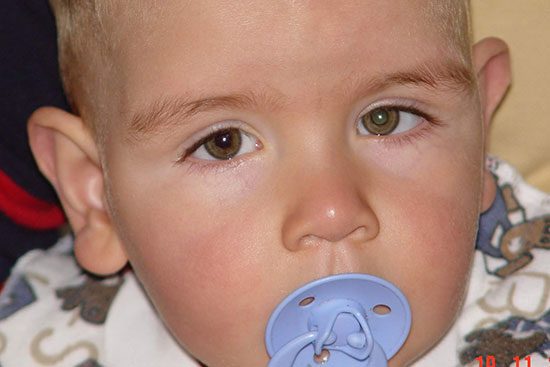About leukocoria or white pupil
Leukocoria or white pupil is a white reflection that can appear in the pupil of one or both eyes. Sometimes white pupil looks a bit pink. If it’s only in one eye, you’ll notice that this eye looks different to the other eye.
You might see white pupil with your naked eye, in photos and/or in certain light.
Sometimes photos will show white pupil in healthy eyes. This happens because of the way photos show light reflecting off the eye.
Less commonly, white pupil seen in photos or with the naked eye can be a sign of a serious eye problem. Serious eye conditions that can cause white pupil include cataracts, retinoblastoma, Coats disease, toxoplasmosis and retinal detachment.
White pupil can appear at any age.
Leukocoria is the medical name for white pupil.
Leukocoria or white pupil: what to look for
Leukocoria or white pupil might look like a:
- cat’s eye
- glassy, milky or transparent eye
- glow, glint or shine in the eye.
If a child has white pupil, you might see it sometimes or all the time.
In healthy eyes, white pupil appears only in photos.
But when white pupil is caused by an eye problem, you might see it both in photos and with your naked eye. You might briefly see white pupil with your naked eye when your child:
- is feeding at night
- is lying on the change table
- looks up at you at bath time
- is looking at you in a slightly darkened room.
If white pupil is caused by an eye problem, you’ll see it more often and it will be more obvious as the problem gets worse.


All children should have an eye test before they start preschool, when they’re 3½-5 years old. Most states and territories run free vision screening programs through local child and family health services or schools. Check with your child and family health nurse, kindergarten, child care centre or school about what’s offered in your area.
Medical help: when to get it for children and teenagers with leukocoria or white pupil
If your child has leukocoria or white pupil, it’s important for them to see a health professional as soon as possible.
See your GP or go to an optometrist to have your child’s eyes examined. They’ll check your child’s eyes to work out whether there might be a serious eye problem causing the white pupil. They’ll also refer your child to an ophthalmologist if necessary.
If a serious eye problem is causing your child’s white pupil, this problem needs to be treated. Early detection and treatment can prevent the problem leading to vision problems or permanent vision loss.
Tests for leukocoria or white pupil
If your child sees an optometrist or is referred to an ophthalmologist for leukocoria or white pupil, this professional will carefully examine your child’s eyes to work out what’s causing it.
The optometrist or ophthalmologist will use an ophthalmoscope to look inside your child’s eye.
Your child’s examination will first involve a fundal reflex (or red reflex) test to check for eye problems. This involves briefly shining a light through the pupil and looking at the reflected light. The appearance of the reflected light can tell the optometrist or ophthalmologist whether there’s an eye problem.
Then the optometrist or ophthalmologist might use special eye drops to make the pupil larger so they can fully examine the inside of your child’s eye. These eye drops might make your child a little bit uncomfortable for 1-2 seconds. They can also blur your child’s vision and make your child’s eyes a bit more sensitive to bright light for a little while. These effects wear off in 2-3 hours, and most children aren’t bothered by them.
The optometrist or ophthalmologist will also examine the eye in other ways. For example, they’ll check that your child’s eyes look in the same direction and that they focus correctly.
And the optometrist or ophthalmologist will also organise any other tests your child needs – for example, an ultrasound.
Treatment for eye problems that cause leukocoria or white pupil
Treatment depends on the eye condition that’s causing the leukocoria or white pupil. Treatment can range from glasses for a mild eye condition to surgery for a more serious eye condition. The aim is to get both eyes working well.
Early treatment of all children’s eye problems leads to better outcomes for children.